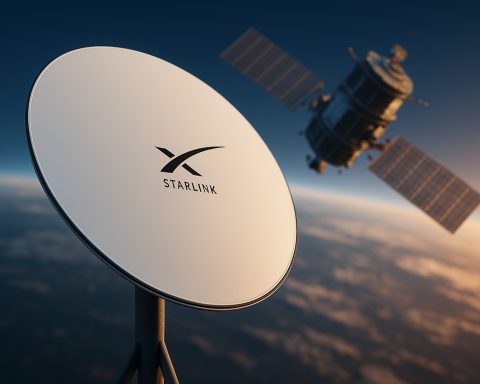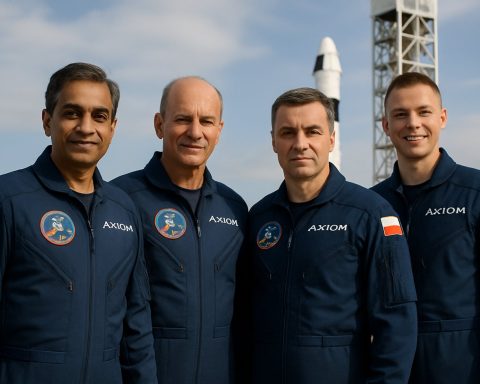- The Southern Pinwheel Galaxy (M83), located 15 million light-years away, long puzzled astronomers due to the absence of a detectable supermassive black hole.
- The James Webb Space Telescope (JWST), with its unmatched sensitivity, unveiled evidence of a hidden supermassive black hole at M83’s core, veiled by cosmic dust.
- JWST detected ionized neon gas, suggesting the presence of an active galactic nucleus (AGN), previously hidden from view.
- This discovery highlights the transformative impact of the JWST on our understanding of the cosmos, challenging assumptions and revealing new insights.
- Researchers are now using other powerful telescopes, such as the Hubble and ALMA, to further study M83’s newfound mysteries.
- The case illustrates how advanced technology can redefine astronomical understanding and reveal unseen cosmic phenomena.
The spiral grandeur of the Southern Pinwheel Galaxy, also known as Messier 83 (or M83), has perplexed astronomers for decades. Although this galactic marvel, located 15 million light-years away, flamboyantly displays its stellar prowess with swirling arms of young stars and vibrant nebulae, it has concealed a secret in its core: the absence of a detectable supermassive black hole. Until recently, scientists stood puzzled, as such cosmic titans are typically ubiquitous in the centers of large galaxies.
Enter the James Webb Space Telescope (JWST), humanity’s most incisive eye on the cosmos. This marvel of modern engineering, with its unparalleled sensitivity, captured what previous instruments could not—a trail of evidence hinting at the presence of a colossal, though hidden, supermassive black hole at the center of M83. Instead of broadcasting its presence with a brilliant display of matter consumption, this black hole sits shrouded, veiled by cosmic dust.
As the JWST peered into the heart of M83, it detected clumps of highly ionized gas, a celestial signature too energetic to be merely the product of regular stellar processes. These glowing pockets of gas, primarily neon, require an intense power source, suggesting an actively feeding black hole enveloped by thick curtains of dust.
This discovery, heralded as a milestone, not only resolves the enigma surrounding M83 but also underscores the JWST’s transformative impact on our understanding of the universe. Many scientists previously dismissed the existence of an active galactic nucleus (AGN) in M83, unable to observe any luminescent evidence. The detection of ionized neon now offers credible evidence of such an AGN, hidden just out of sight.
Excited whispers ripple through the scientific community as researchers direct other high-powered telescopes like the Hubble, the Atacama Large Millimeter/submillimeter Array (ALMA), and the Very Large Telescope (VLT) towards M83. The goal: to further unmask the mysteries of this once-elusive AGN.
The key takeaway of this cosmic detective story is how assumptions in science can be upended by new technology, driving exploration into uncharted realms. The JWST is illuminating the universe with fresh clarity, revealing untold stories that redefine our celestial knowledge. As astronomers continue to unravel the intricate dance of galaxies and their hidden giants, one thing is certain: the universe remains an ever-expanding tapestry of wonder and surprise.
Astronomers Thrilled by Hidden Secrets in the Southern Pinwheel Galaxy
Exploring the Recent Discovery in M83’s Core
The recent revelations about the Southern Pinwheel Galaxy, or Messier 83 (M83), underscore the transformative power of the James Webb Space Telescope (JWST). This groundbreaking discovery not only uncovers a hidden supermassive black hole but also exemplifies how advanced technology can challenge long-held astronomical beliefs.
How the JWST Revolutionized Our View
The JWST’s detection of ionized neon is particularly crucial. Unlike typical astrophysical processes, which fail to account for such high levels of ionization, this phenomenon suggests the presence of a supermassive black hole, actively consuming matter, albeit hidden by cosmic dust.
– Capabilities of the JWST: Boasting a mirror 2.7 times larger than that of the Hubble Space Telescope, the JWST offers higher resolution and unprecedented sensitivity in infrared wavelengths. This allows it to peer through dense dust clouds that obscure the view of other telescopes.
Market Forecast: The Future of Telescope Technology
The advancements in telescope technology, epitomized by the JWST, are constantly setting new benchmarks:
– Global Telescope Market Trends: Anticipated to grow at a CAGR of 7.3% from 2022 to 2030. This surge is driven by the rising interest in astrophotography and astronomical research, fostering innovation in telescope optics and integration of AI for space exploration.
– Real-World Use Cases: Researchers can model the dynamics within galactic cores more precisely, crucial for cosmology studies and understanding the universe’s formation and evolution.
Instruments in the Galactic Detective Arsenal
As a follow-up, renowned telescopes are now aimed at M83 for further exploration:
– Hubble Space Telescope: While it operates primarily in visible and ultraviolet wavelengths, Hubble will complement the JWST’s findings by providing detailed optical data.
– Atacama Large Millimeter/submillimeter Array (ALMA): Operating at high altitude in Chile, ALMA’s millimeter and submillimeter observations can trace molecular gas and dust, providing invaluable supplementary data about the environment around the black hole.
– Very Large Telescope (VLT): Located in Chile’s Atacama Desert, the VLT can offer precise measurements concerning the galaxy’s structure and dynamics at optical wavelengths.
Key Questions and Discovery Implications
– Does the Hidden Black Hole Affect M83’s Overall Structure? Current models suggest a significant role in stabilizing the galaxy’s central region and influencing star formation processes.
– Why Was It Invisible Until Now? Layers of interstellar dust served as a cosmic veil, absorbing visible light while allowing infrared emissions to escape—allowing the JWST to detect its hidden presence.
Quick Tips for Astronomy Enthusiasts
– Stay updated with real-time galaxy studies and discoveries by following reports from leading observatories.
– Engage with online courses and webinars about recent technological advancements in astronomy to deepen your understanding of cosmic phenomena and instrumentation.
For more insight into telescope technology and astronomical discoveries, visit the official websites of organizations like NASA and European Southern Observatory (ESO).
The ongoing exploration of Messier 83 is a reminder of how much more there is to discover as we peer deeper into the cosmos. The work of the JWST has only just begun, promising to unveil even more secrets of our universe.







